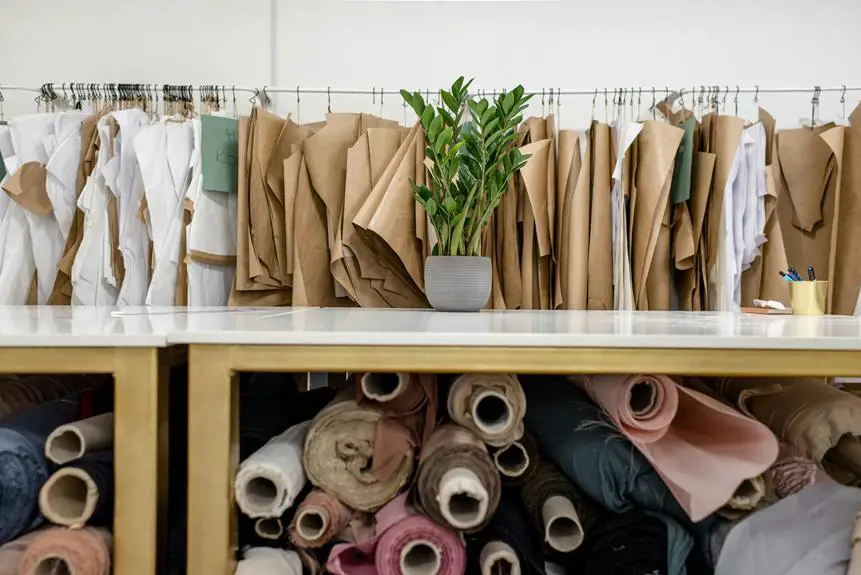When you're preparing fabric for applique work, choosing the right stiffening method is crucial for achieving clean lines and durability. You've got options like spray starch, fabric stiffeners, or even homemade solutions that can bring your creative vision to life. Each method has its own advantages, so understanding how they work with different fabric types can make all the difference. But before you pick a technique, consider how the choice affects not just your project, but also the long-term care of your fabric. What's the best approach for your specific needs?
Table of Contents
Key Takeaways
- Choose a suitable stiffening agent like spray starch, fabric stiffener, or fusible web based on fabric type and desired stiffness.
- Apply the stiffening agent evenly, allowing each layer to dry before adding more for optimal hold and structure.
- Use iron-on stabilizers to add permanent structure, adhering them directly to the fabric with heat for a professional finish.
- Test on scrap fabric first to ensure the stiffness meets your project's needs without altering the fabric's appearance.
Understanding Fabric Stiffening
Fabric stiffening is essential for achieving clean edges and precise shapes in your applique projects. When you stiffen the fabric, you enhance its structure, allowing it to hold its form, especially during the cutting and sewing processes. This stability makes it easier to handle, reducing the likelihood of fraying or stretching, which can ruin your design.
To get started, choose the right fabric for your applique. Thinner fabrics can benefit significantly from stiffening, as they often lack the body needed to maintain intricate shapes. You'll find that the stiffened fabric allows you to create sharper corners and smoother curves, resulting in a more polished look.
Before you begin stitching, make sure to apply the stiffening agent evenly. This will ensure that every part of your fabric retains its shape. After stiffening, you can cut your pieces with confidence, knowing they won't distort as you work.
Remember to let your fabric dry completely before proceeding, as this affects the final outcome of your project. By understanding and implementing fabric stiffening, you'll elevate your applique skills and create stunning, professional-looking pieces.
Types of Stiffening Agents
Several types of stiffening agents can enhance your applique work, each offering unique benefits for different fabric types.
One popular option is spray starch, which provides a light hold without making the fabric overly rigid. It's great for cottons and blends, allowing for easy manipulation during stitching.
Another choice is fabric stiffener, often available in liquid form. You can dilute it to achieve the desired stiffness. This works well with heavier fabrics like canvas, giving your applique a structured appearance.
If you're looking for a temporary solution, consider using a water-soluble stabilizer. It supports your fabric during the sewing process, and you can rinse it away afterward, leaving no residue.
For a more permanent solution, try using a fusible web or interfacing. These products bond to the fabric when heated, creating a stable base for your applique.
Lastly, consider cornstarch or homemade mixtures for a natural option. They can be an economical choice, but may require experimentation to achieve the perfect stiffness.
Choosing the right stiffening agent depends on your fabric and the look you want to achieve, so don't hesitate to try different options to find your favorite.
Iron-On Stabilizers
Iron-on stabilizers offer a convenient way to add structure to your applique work, providing a strong base that adheres directly to the fabric when heat is applied. These stabilizers come in various weights and types, allowing you to choose the one that best suits your project. Before you begin, make sure to select a stabilizer that matches your fabric's weight and texture for optimal results.
To use an iron-on stabilizer, cut it slightly larger than the area you plan to applique. Place the rough side against the wrong side of your fabric. Then, using a medium heat setting without steam, press the iron onto the stabilizer for about 10-15 seconds. Make sure to follow the manufacturer's instructions for best results.
Once it's adhered, you can cut away any excess stabilizer around your design. This method not only prevents fraying but also gives your applique a professional finish. Remember to test a small piece first if you're unsure how the stabilizer will react with your fabric.
With the right iron-on stabilizer, you'll find that your applique projects become easier and more polished.
Spray Starch Techniques
When you're working with spray starch for your applique projects, choosing the right starch is crucial for achieving the desired stiffness.
You'll also want to understand the best application methods to ensure even coverage, along with tips for drying and setting your fabric.
Let's explore these key points to help you get the most out of your spray starch technique.
Choosing the Right Starch
Choosing the right spray starch can make a significant difference in the stiffness and stability of your fabric for applique work. Look for a starch specifically designed for sewing and crafting; these often provide a stronger hold without leaving residue.
There are two main types of spray starch: regular and heavy-duty. Regular starch gives light to medium stiffness, which is great for delicate fabrics or when you want flexibility. Heavy-duty starch, on the other hand, offers a firmer hold, making it ideal for thicker materials or intricate designs that need to maintain their shape.
When selecting your starch, consider the finish as well. Some products provide a crisp finish, while others may leave a softer touch. If you're looking for a fabric that's easy to work with but still holds its structure, a medium-firm finish might be your best bet.
Lastly, check the label for any special features, like scent or eco-friendliness, if those matter to you. Experiment with different brands and types until you find the one that gives you the perfect balance of stiffness and ease of use for your applique projects.
Application Methods Explained
Apply spray starch evenly to your fabric for the best results in achieving the desired stiffness for your applique work. Start by laying your fabric flat on a clean surface. Shake the spray starch canister well, then hold it about 10-12 inches away from the fabric. This distance helps you apply a fine mist that dries evenly.
When spraying, make sure to cover the entire surface, but don't soak it. A light, consistent application is key.
Here are some tips to help you get the most out of the spray starch:
- Test First: Always test the spray on a scrap piece of fabric to ensure it gives you the stiffness you want without altering the color or texture.
- Layering: If you need more stiffness, let the first layer dry slightly, then apply a second layer of starch.
Once you've applied the spray starch, you'll find your fabric becomes much easier to work with for your applique projects!
Drying and Setting Tips
To ensure your fabric maintains its stiffness after applying spray starch, let it dry completely in a well-ventilated area. This not only helps the starch set better but also prevents any mustiness from lingering in the fabric.
Lay your fabric flat on a clean surface or hang it up to air dry. Avoid using heat sources like hairdryers, as they can cause the starch to clump or lose effectiveness.
Once your fabric is dry, check the stiffness. If it feels too soft, you can apply another light coat of spray starch. Be sure to let it dry again.
When you're satisfied with the stiffness, press the fabric with a dry iron on a low setting. This extra step helps set the starch and smooths out any wrinkles.
If you're working on intricate appliqué, consider using a pressing cloth between your iron and the fabric to protect it.
Homemade Stiffening Solutions
If you're looking for an economical way to stiffen fabric for applique work, homemade stiffening solutions can be a great alternative to store-bought options. These solutions are easy to make and often use items you already have at home.
Here are three effective recipes you can try:
- Cornstarch Solution: Mix one tablespoon of cornstarch with one cup of water. Heat until it thickens, then let it cool. This solution provides a flexible stiffness that's perfect for delicate fabrics.
- White Glue Mixture: Combine one part white glue with two parts water. This solution dries clear and offers a sturdy finish, making it ideal for heavier fabrics.
Once you've made your choice, simply soak your fabric in the solution, wring it out, and let it dry.
You'll find that these homemade options not only save you money but also give you control over the stiffness level you want for your applique projects. Happy crafting!
Application Tips for Applique
Once you've stiffened your fabric using homemade solutions, you're ready to explore some effective application tips for your applique projects.
First, always choose the right needle and thread for your fabric. A sharp needle works best for tightly woven fabrics, while a heavier needle is ideal for thicker materials.
Next, secure your applique pieces with a temporary adhesive spray or fabric glue to avoid shifting during stitching. This step saves you from frustration later on!
When it comes to stitching, use a small zigzag or straight stitch around the edges of your applique to keep it secure. This not only enhances durability but adds a decorative touch.
Consider using a contrasting thread color to make your stitches pop, or match it to your applique for a subtle look. If you're working with intricate designs, a free-motion foot can help you navigate tight curves more easily.
Lastly, don't rush the process. Take your time to ensure even stitching and precise placement.
Caring for Stiffened Fabric
Once you've stiffened your fabric for applique, it's crucial to know how to care for it properly.
You'll want to follow specific washing techniques to maintain its shape and durability.
Additionally, storing your stiffened fabric correctly will help preserve its quality and keep it ready for your next project.
Washing Techniques
Caring for stiffened fabric requires gentle washing techniques to maintain its structure and appearance. When you need to clean your fabric, avoid harsh methods that could compromise the stiffness.
Here are some tips to keep in mind:
- Hand wash: Use lukewarm water and a mild detergent. Gently agitate the fabric without scrubbing it to prevent damage.
- Rinse carefully: After washing, rinse the fabric in cool water until all detergent is removed. Avoid wringing or twisting, as this can cause distortion.
Storage Recommendations
To keep your stiffened fabric in top condition, store it flat or rolled rather than folded to prevent creases and maintain its shape. When you roll the fabric, loosely wrap it around a tube or a piece of cardboard to avoid any stress on the fibers. This method helps preserve the stiffness and prevents unwanted wrinkles.
If you have multiple pieces, consider using acid-free tissue paper between them. This will reduce friction and help keep them from sticking together. Avoid plastic bags for long-term storage, as they can trap moisture and lead to mold or mildew. Instead, opt for breathable fabric storage bags or boxes.
Keep your stiffened fabric in a cool, dry place away from direct sunlight. Sun exposure can cause fading and weaken the stiffness over time. If you notice any dust accumulating, gently shake it off or use a soft brush to remove it.
Lastly, always check your fabric before use. If it seems to have lost some stiffness, you can reapply your stiffening agent as needed, ensuring your projects always look their best. Taking these steps will help you maintain your stiffened fabric for future applique work.
Frequently Asked Questions
Can I Use Fabric Stiffeners on Knitted Fabrics?
Yes, you can use fabric stiffeners on knitted fabrics. Just make sure to test a small section first to see how it reacts, as different fibers can respond uniquely to stiffening agents.
How Long Does Fabric Stiffening Last After Application?
Fabric stiffening typically lasts several washes, but the duration depends on the product used and fabric type. You should check the manufacturer's instructions to ensure you understand how to maintain the stiffness effectively.
Is It Safe to Wash Stiffened Fabric?
Yes, you can wash stiffened fabric, but it's best to check the specific product instructions first. Some stiffeners may not withstand washing, so always test a small area to ensure it holds up well.
Can I Combine Different Stiffening Methods?
Yes, you can combine different stiffening methods! Experimenting with various techniques can yield unique textures and effects. Just make sure each method suits your fabric and desired outcome for the best results.
Will Stiffening Affect Fabric Color or Texture?
Stiffening can change your fabric's color or texture. It might darken the shade or create a rougher feel. Always test on a sample piece first to see how your chosen stiffening method affects it.
- How Does Ring Spun Cotton Affect Garment Fit and Shape Retention? - August 13, 2024
- What Are the Challenges in Producing Ring Spun Cotton? - August 13, 2024
- Is Ring Spun Cotton Suitable for Plus-Size Clothing? - August 13, 2024






